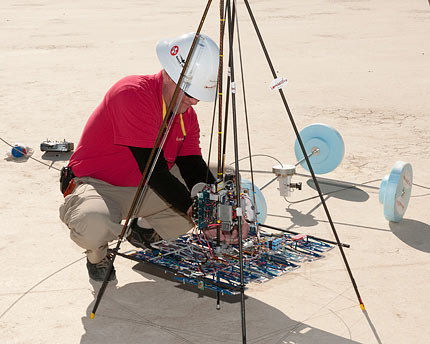Seattle Team Wins $900,000 in Space Elevator Contest

Thisstory was updated Friday at 9:50 p.m. EST.
ASeattle-based team has won $900,000 in this year's Space Elevator Games, a NASA-sponsoredcontest to build machines powered by laser beams that can climb a cable in thesky.
Thehomemade cable-climber built by the team LaserMotive of Washington state climbeda 3,000-foot (900-meter) tether suspended by a helicopter at a speed of about 8mph (13 kph) during a Wednesday attempt. The entry ultimately managed to climb the cable four times in two days, witha best time of about 3 minutes and 48 seconds.
The featwas the bestperformance yet of a miniature space elevator prototype and qualifiedLaserMotive to win the second-level prize of NASA?s $2 million Power BeamingChallenge this week at the Dryden Flight Research Center at Edwards Air ForceBase in the California desert. The contest requires competitors to beam powerfrom a remote source to propel their vehicles up a 1/4-inch thick steel cabledangling from a helicopter.
The 2009 SpaceElevator Games are the first in which prize money has been awarded and has"been a very successful competition," said NASA's CentennialChallenges director Andy Petro. "Power beaming is truly a 21st centurytechnology."
DespiteLaserMotive?s success, it is still a long way away from what would be neededto carry humans to Earth orbit, as proponents envision.
Spaceelevators were first popularized in the 1970s by the science fiction novelsof Arthur C. Clarke, as a means to reach space without using a rocket. Instead,a ship could climb along a fixed structure, like a beam or cable, suspended inspace by a permanent geostationary satellite 22,000 miles (35,000 km) aboveEarth. The sticking points are the need for a super-strong, yet light, materialfor the tether, and a good way to anchor the other end securely. Not to mentionthe vehicle to climb it.
Get the Space.com Newsletter
Breaking space news, the latest updates on rocket launches, skywatching events and more!
That'swhere the Space Elevator Games come in. Any team that can power their entrant for an averagespeed of 11 mph (18 kph) can qualify for a portion of the total $2 millionprize purse on offer. The competition is sponsored by the Spaceward Foundationand NASA's CentennialChallenges program aimed to spur development in space exploration.
An attemptby the Kansas City Space Pirates on Wednesday fell short of the speed requirementand got stuck partway up the cable during a Friday climb attempt. A climber builtby the University of Saskatchewan Space Design Team was unable to competeduring the three-day contest because of a series of technical glitches, NASAofficials said.
Had LaserMotive's entry managedto climb the entire length of the cable in under 3 minutes, it wouldhave won the entire $2 million prize. As it stands, the remaining $1.1 million in prize moneyremains available for future competitions, contest organizers said.
- Video - Star Trek's Warp Drive: Are We There Yet?
- Space Elevator: Hoist to the Heavens
- X-Prize Space Elevator Race Ends With No Winners
Join our Space Forums to keep talking space on the latest missions, night sky and more! And if you have a news tip, correction or comment, let us know at: community@space.com.

Clara Moskowitz is a science and space writer who joined the Space.com team in 2008 and served as Assistant Managing Editor from 2011 to 2013. Clara has a bachelor's degree in astronomy and physics from Wesleyan University, and a graduate certificate in science writing from the University of California, Santa Cruz. She covers everything from astronomy to human spaceflight and once aced a NASTAR suborbital spaceflight training program for space missions. Clara is currently Associate Editor of Scientific American. To see her latest project is, follow Clara on Twitter.









